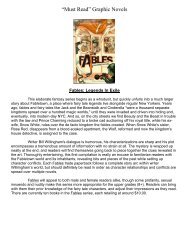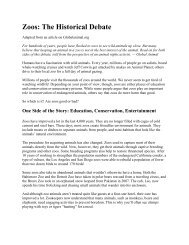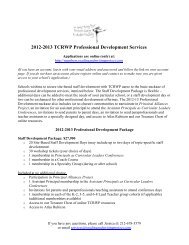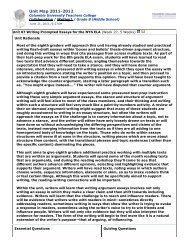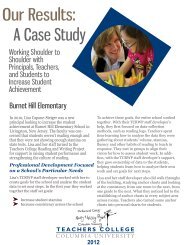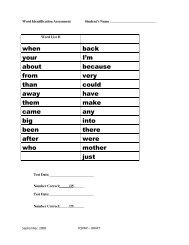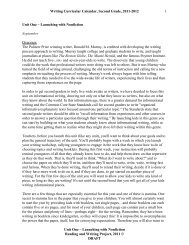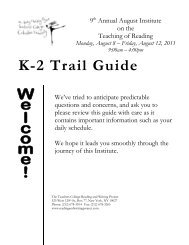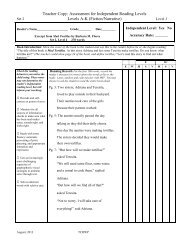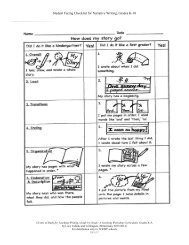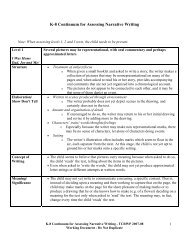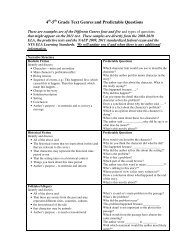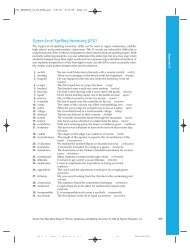Continuum for Narrative Writing â Third Grade S tru cture
Continuum for Narrative Writing â Third Grade S tru cture
Continuum for Narrative Writing â Third Grade S tru cture
Create successful ePaper yourself
Turn your PDF publications into a flip-book with our unique Google optimized e-Paper software.
<strong>Grade</strong> 1(1 point)<strong>Continuum</strong> <strong>for</strong> <strong>Narrative</strong> <strong>Writing</strong> – <strong>Third</strong> <strong>Grade</strong>1.5 pts <strong>Grade</strong> 2(2 points)Updated 11/6/122.5 pts <strong>Grade</strong> 3(3 points)3.5 pts <strong>Grade</strong> 4(4 points)ScoreOverallI wrote about when I didsomething.I wrote about one timewhen I did something.I told the story bit by bit.MidlevelMidlevelMidlevelI wrote the important part ofan event, bit by bit and tookout unimportant parts.S<strong>tru</strong><strong>cture</strong>LeadTransitionsI tried to make abeginning <strong>for</strong> my story.I put my pages in order. Iused words like and andthen, so.I thought about how towrite a good beginningand chose a way to startmy story. I chose theaction, talk or settingthat would make a goodbeginning.I told the story in orderby using words likewhen, then, after.The beginning of my storyhelps my readers know whothe people are and what thesetting is in my story.I told my story in order byusing phrases like a littlelater, or after that.MidlevelMidlevelMidlevelMidlevelMidlevelMidlevelI wrote a beginning thatshows what is happening andwhere. It gets the reader intothe world of the story.I used words and phrases toshow how much time went by,with phrases like mark time,like just then, suddenly (toshow when things happenedquickly) or after a while, alittle later (to show when alittle time passed).EndingI found a way to end mystory.I chose the action, talkor feeling that wouldmake a good ending.I chose the action, talk orfeeling that would make agood ending, and worked towrite it well.MidlevelMidlevelMidlevelWhat happens at the end ofthe story connects to thebeginning or the middle.I used action, dialogue, orfeeling to bring my story to aclose.OrganizationI wrote my story acrossthree or more pages.I wrote lots of lines on apage and wrote acrosslots of pages.I used paragraphs andskipped lines to separatewhat happened first fromwhat happened later (andfinally) in my story.MidlevelMidlevelMidlevelI used paragraphs to separatethe different parts or times ofthe story, or to show when anew person is speaking.Total(Elaboration and Description are double weighted categories. Whatever score a student would get in these categories is worth double the amount of points. Ex. if a student exceeds expectations in Elaboration, then thatstudent would receive 8 points instead of 4 points. If a student meets standards in Elaboration, then that student would receive 6 points instead of 3 points, and so on.)©Units of Study <strong>for</strong> Teaching <strong>Writing</strong>, <strong>Grade</strong> by <strong>Grade</strong>: A Yearlong Workshop Curriculum, <strong>Grade</strong>s K-8,by Lucy Calkins and Colleagues (Heinemann, 2013/2014)For distribution only in TCRWP schoolsDRAFT
DevelopmentElaborationDescription<strong>Grade</strong> 1(1 point)I put the pi<strong>cture</strong> from mymind onto the page. Ihave details in pi<strong>cture</strong>sand words.I used labels and words togive details.<strong>Continuum</strong> <strong>for</strong> <strong>Narrative</strong> <strong>Writing</strong> – <strong>Third</strong> <strong>Grade</strong>I chose strong wordsthat would help readerspi<strong>cture</strong> my story.Updated 11/6/122.5 pts <strong>Grade</strong> 3(3 points)I worked to show what washappening to and inside mycharacters.I didn’t just tell my story, Iwrote my story in ways thatgot readers to pi<strong>cture</strong> whatwas happening and to bringmy story to life.3.5 pts <strong>Grade</strong> 4(4 points)1.5 pts <strong>Grade</strong> 2(2 points)I tried to bring myMidleveldetails, talk, andpeople to life withactions.MidlevelMidlevelMidlevelMidlevelMidlevelI added more to the heart ofmy story, including not onlyactions and dialogue but alsothought and feelings.I showed why characters dowhat they do by includingtheir thinking.I made some parts of the storygo quickly, some slowly.I included precise andsometimes sensory details andused figurative language(simile, metaphor,personification) to bring mystory to life.Score(x2)(x 2)I used a storytelling voice andconveyed the emotion or toneof my story throughdescription, phrases, dialogue,and thoughts.Total<strong>Grade</strong> 1(1 point)1.5 pts <strong>Grade</strong> 2(2 points)2.5 pts <strong>Grade</strong> 3(3 points)3.5 pts <strong>Grade</strong> 4(4 points)ScoreLanguageConventionsSpellingI used all I know aboutwords and chunks ofwords (“at,” “op,” “it”…)to help me spell.I spelled all the WordWall Words right andused the Word Wall tohelp me spell other wordsTo spell a word, I usedwhat I know aboutspelling patterns(“tion,” “er,” “ly”, etc.)I spelled all of the WordWall words correctlyand used the Word Wallto help me figure outhow to spell otherwords.(Elaboration and Description are double weighted categories. Whatever score a student would get in these categories is worth double the amount of points. Ex. if a student exceeds expectations in Elaboration, then thatstudent would receive 8 points instead of 4 points. If a student meets standards in Elaboration, then that student would receive 6 points instead of 3 points, and so on.)I used what I know aboutspelling patterns to help mespell and edit be<strong>for</strong>e I wrotemy final draft.I got help from others tocheck my spelling andpunctuation be<strong>for</strong>e I wrotemy final draft.MidlevelMidlevelMidlevel©Units of Study <strong>for</strong> Teaching <strong>Writing</strong>, <strong>Grade</strong> by <strong>Grade</strong>: A Yearlong Workshop Curriculum, <strong>Grade</strong>s K-8,by Lucy Calkins and Colleagues (Heinemann, 2013/2014)For distribution only in TCRWP schoolsDRAFTI used what I know aboutword families and spellingrules to help me spell andedit. I used the word wall anddictionaries to help me whenneeded.
Punctuation<strong>Grade</strong> 1(1 point)I ended sentences withpunctuation.<strong>Continuum</strong> <strong>for</strong> <strong>Narrative</strong> <strong>Writing</strong> – <strong>Third</strong> <strong>Grade</strong>1.5 pts <strong>Grade</strong> 2(2 points)I used quotation marksto show what peoplesaid.Updated 11/6/122.5 pts <strong>Grade</strong> 3(3 points)I punctuated dialoguecorrectly, with commas andquotation marks.3.5 pts <strong>Grade</strong> 4(4 points)MidlevelMidlevelMidlevelWhen writing long, complexsentences, I used commas tomake them clear and correct.ScoreI used a capital letter <strong>for</strong>names.I used commas in datesand lists.When I used words likecan’t and don’t, I put inthe apostrophe.While writing, I putpunctuation at the end ofevery sentence.I wrote in ways that helpedreaders read with expression,reading some parts quickly,some slowly, some parts inone sort of voice and othersin another.TotalTeachers, when this is totally finished, each category will refer to “the writer” rather than “I”. We are giving out these assessments so they can be used immediately, after giving the on demands, andthey can be used with kids <strong>for</strong> self-assessment and setting goals. We have created these continua so you will have your own place to pull together scores of student work.Scoring Guide:In each row, circle the descriptor in the column that matches the student work. Scores in the categories of Elaboration and Description are worth double the pointvalue (2, 3, 4, 5, 6, 7, or 8 instead of 1, 1.5, 2, 2.5, 3, 3.5, or 4).Total the number of points, and track students’ progress by seeing when the total points increase.(Elaboration and Description are double weighted categories. Whatever score a student would get in these categories is worth double the amount of points. Ex. if a student exceeds expectations in Elaboration, then thatstudent would receive 8 points instead of 4 points. If a student meets standards in Elaboration, then that student would receive 6 points instead of 3 points, and so on.)©Units of Study <strong>for</strong> Teaching <strong>Writing</strong>, <strong>Grade</strong> by <strong>Grade</strong>: A Yearlong Workshop Curriculum, <strong>Grade</strong>s K-8,by Lucy Calkins and Colleagues (Heinemann, 2013/2014)For distribution only in TCRWP schoolsDRAFT
Total score: ________<strong>Continuum</strong> <strong>for</strong> <strong>Narrative</strong> <strong>Writing</strong> – <strong>Third</strong> <strong>Grade</strong>Updated 11/6/12If you want to translate this score into a grade, you can use the provided table to score each student on a scale from 0 – 4.Number of PointsScaled Score1-11 111.5-16.5 1.517-22 222.5-27.5 2.528-33 333.5-38.5 3.539-44 4(Elaboration and Description are double weighted categories. Whatever score a student would get in these categories is worth double the amount of points. Ex. if a student exceeds expectations in Elaboration, then thatstudent would receive 8 points instead of 4 points. If a student meets standards in Elaboration, then that student would receive 6 points instead of 3 points, and so on.)©Units of Study <strong>for</strong> Teaching <strong>Writing</strong>, <strong>Grade</strong> by <strong>Grade</strong>: A Yearlong Workshop Curriculum, <strong>Grade</strong>s K-8,by Lucy Calkins and Colleagues (Heinemann, 2013/2014)For distribution only in TCRWP schoolsDRAFT



